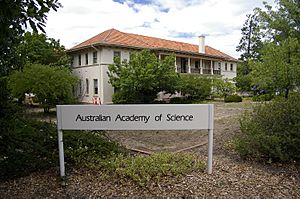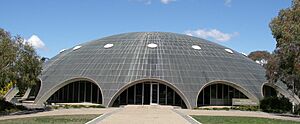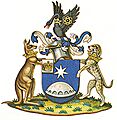Australian Academy of Science facts for kids
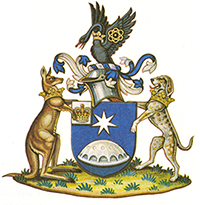
Academy Coat of Arms
|
|
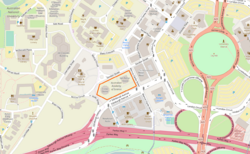
location of the Australian Academy of Science in Canberra
|
|
| Formation | 1954 |
|---|---|
| Headquarters | Canberra, Australian Capital Territory |
|
Membership
|
≈500 Fellows |
|
President
|
Chennupati Jagadish |
| Website | www.science.org.au |
The Australian Academy of Science is a special group for top scientists in Australia. It was started in 1954 by many important Australians, including some who were also part of the Royal Society in London. The Academy's main office is in Canberra, inside a famous building called the Shine Dome.
Contents
A Look at History
The idea for a national science group in Australia began a long time ago. In 1919, a group called the Australasian Research Council was formed. It later became the Australian National Research Council (ANRC) in 1921.
However, by the 1950s, people felt the ANRC wasn't quite strong enough to be Australia's main science body. So, in 1951, scientists suggested creating a new group. This new group, the Australian Academy of Science, officially started in 1954. It took over most of the ANRC's jobs, and the ANRC closed down in 1955. The first president of the Academy was Sir Mark Oliphant.
What the Academy Does
The Australian Academy of Science is like the Royal Society in the UK. It has a special permission from the King, which means it's an independent group but also supported by the government.
The Academy's main goals are to encourage science and science education. They want to share scientific knowledge with everyone.
They focus on four main areas:
- Finding and celebrating scientists who have done amazing work.
- Teaching people about science and making it interesting.
- Helping the government make good decisions about science.
- Working with scientists from other countries.
The Academy also runs 22 National Committees for Science. These committees are places where scientists from different fields can talk about important science topics in Australia.
Science Education Programs
Teaching science is a very important part of what the Australian Academy of Science does. As of 2016, they had several projects to help students and teachers:
- Primary Connections: Helps primary school students learn science.
- Science by Doing: Encourages hands-on science learning.
- Nova: science for curious minds: Provides interesting science information.
- reSolve: Mathematics by Inquiry: Focuses on learning maths by exploring.
- They also create Science booklets and a program called Brain Box.
The Shine Dome: A Unique Building
The Shine Dome is a very famous building in Canberra. It's known for its unusual round shape, and some people even call it "The Martian Embassy" because it looks so unique. Sir Roy Grounds designed it. When it was finished in 1959, its dome was the biggest in Australia, measuring about 45.75 meters across.
The building's design was chosen in 1956. It features a huge concrete dome weighing 710 tonnes, supported by 16 thin pillars. The concrete is thick at the bottom (about 60 cm) and thinner at the top (about 10 cm). The dome supports itself without any inside walls holding it up. It cost £200,000 to build. The first stone for the building was laid in 1958 by Australia's Prime Minister, Robert Menzies. This stone was actually a piece from a very old telescope built in 1869!
The building was first named Becker House in 1962, after Sir Jack Ellerton Becker. In 2000, it was renamed the Shine Dome to honor John Shine, who gave a lot of money to help fix it up.
Inside, the Shine Dome has three floors. On the ground floor, there's a main hall called the Ian Wark Theatre, which seats 156 people. There are also rooms for meetings and offices. The upper floor has a gallery for the theatre and the Adolf Basser Library. The basement is used to store old science records from Australia.
On January 20, 2020, a big hailstorm hit the Dome. It broke skylights and dented the copper roof.
Academy Fellows: Top Scientists
The Australian Academy of Science has about 500 leading Australian scientists as its "Fellows." These are scientists who their peers (other scientists) agree have made amazing contributions to their field. Each year, up to 20 new Fellows can be chosen.
Sometimes, a few people who have helped science in other ways (not just through their own research) can also become Fellows. A small number of important foreign scientists who have strong connections to Australian science can become "Corresponding Members."
When someone is a Fellow of the Australian Academy of Science, they can use the letters FAA after their name.
First Fellows of the Academy
When the Academy started in 1954, there were 24 first members, called the Foundation Fellows. Here are some of them and their fields:
| Name | Field |
|---|---|
| Frank Macfarlane Burnet | Virology and immunology (won a Nobel Prize) |
| John Eccles | Neuroscience (won a Nobel Prize) |
| Mark Oliphant | Physics |
| Douglas Mawson | Geology |
| Joseph Lade Pawsey | Radiophysics and astronomy |
| Sydney Sunderland | Neuroscience |
Academy Presidents
The Academy has had many important scientists as its President over the years. Here are some of them:
- Sir Mark Oliphant (1954–1957)
- Sir John Eccles (1957–1961)
- Sir Frank Macfarlane Burnet (1965–1969)
- Professor Suzanne Cory (2010–2014)
- Professor John Shine (2018–2022)
- Professor Chennupati Jagadish (2022–present)
Awards for Scientists
The Academy gives out many awards to celebrate great scientific work. These awards are given at different stages of a scientist's career.
- Early Career Awards: These are for scientists who are just starting out. Examples include the Anton Hales Medal for Earth sciences, the Dorothy Hill Medal for female researchers in Earth sciences, and the Pawsey Medal for physics.
- Mid Career Awards: These are for scientists who are further along in their careers, like the Gustav Nossal Medal for health researchers.
- Career Awards: These awards recognize scientists for their achievements over their whole life. Examples are the Macfarlane Burnet Medal and Lecture for biological sciences and the Matthew Flinders Medal and Lecture for physical science.
There are also other awards, like the Academy Medal for people who help science in ways other than research.
Other Science Groups in Australia
Besides the Australian Academy of Science, there are three other similar groups in Australia. They focus on different areas:
- The Australian Academy of the Humanities (for arts and culture)
- The Academy of the Social Sciences in Australia (for social studies)
- The Australian Academy of Technological Sciences and Engineering (for technology and engineering)
These four Academies work together through a group called the Australian Council of Learned Academies.
Images for kids
See also
 In Spanish: Academia Australiana de Ciencias para niños
In Spanish: Academia Australiana de Ciencias para niños


